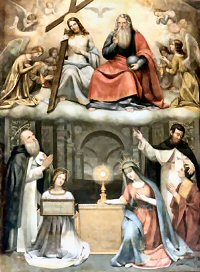Ordinary Time: January 14th
Monday of the First Week of Ordinary Time
Other Commemorations: St. Felix of Nola, Priest (RM)
Free eBook:

|
| Free eBook: Liturgical Year 2023-2024, Vol. 4 |
» Enjoy our Liturgical Seasons series of e-books!
According to the 1962 Missal of St. John XXIII the Extraordinary Form of the Roman Rite, today is the feast of St. Felix who lived in the third century. He was a priest and suffered greatly in the Decian persecution. The tomb of St. Felix at Nola, a small town in the south of Italy, was a much frequented place of pilgrimage in Christian antiquity, and in the Middle Ages veneration of him spread throughout the west. Along with St. Hilary his feast is celebrated today on the Extraordinary Form Calendar. St. Hilary's feast is celebrated on January 13 in the Ordinary Form Calendar.
It is also the feast of the Infant Jesus of Prague. The image of the Child Jesus known as the “Infant Jesus of Prague” was in reality of Spanish origin. In the 17th century, this beautiful statue was brought by a Spanish princess to Bohemia and presented to a Carmelite monastery. For many years this statue has been enshrined on a side altar in the Church of Our Lady of Victory in the city of Prague. It is of wax, and is about nineteen inches high. It is clothed in a royal mantle, and has a beautiful jeweled crown on its head. Its right hand is raised in blessing; its left holds a globe signifying sovereignty.
St. Felix of Nola
 St. Felix was a priest at Nola, near Naples in Italy. His father, a Romano-Syrian soldier, was a landowner in Nola. Felix suffered persecution under the Emperor Decius, but himself escaped from prison and rescued his bishop, St. Maximus of Nola, in miraculous circumstances. Legend says he was freed by an angel so he could help his sick bishop. Felix hid Maximus from soldiers in a vacant building. When the two were safely inside, a spider quickly spun a web over the door, fooling the imperial forces into thinking it was long abandoned, and they left without finding the Christians. The two managed to hide from authorities until the persecution ended with the death of Decius in 251.
St. Felix was a priest at Nola, near Naples in Italy. His father, a Romano-Syrian soldier, was a landowner in Nola. Felix suffered persecution under the Emperor Decius, but himself escaped from prison and rescued his bishop, St. Maximus of Nola, in miraculous circumstances. Legend says he was freed by an angel so he could help his sick bishop. Felix hid Maximus from soldiers in a vacant building. When the two were safely inside, a spider quickly spun a web over the door, fooling the imperial forces into thinking it was long abandoned, and they left without finding the Christians. The two managed to hide from authorities until the persecution ended with the death of Decius in 251.
Felix was known far and wide for his generosity to the poor, and refused to go to law to recover an impounded estate. After Bishop St. Maximus‘ death, Felix was chosen as bishop of Nola, but he declined, favoring Quintus, a “senior” priest who had seven days more experience than Felix. Felix worked to farm his remaining land, and gave most of the proceeds to people even poorer than himself.
He died around 255-260 A.D. Although Felix died of natural causes, he is normally listed as a martyr because of the torture, imprisonment, and privations he experienced in the persecutions.
Most of the little information we have on St. Felix came from the letters and poetry of St. Paulinus of Nola. Over a century later St. Paulinus wrote of the crowds that came from all over Italy to the shrine of St. Felix, of the miracles that took place there, and of the assistance he had himself received from Felix's intercession.
—Adapted from A Dictionary of Saints by Donald Attwater and CatholicSaints.info
Patronage: spiders; keeping of spiders; against spider bites; against eye disease; against eye trouble; against false witness; against lies; against perjury; domestic animals; eyes; Nola, Italy
Symbols and Representation: cobweb; deacon in prison; spiderweb; young priest carrying an old man (Maximus) on his shoulders; young priest chained in prison with a pitcher and potsherds near him; young priest with a bunch of grapes (symbolizes his care of the aged Maximus); young priest with a spider; young priest with an angel removing his chains
Highlights and Things to Do:
- Read more about St. Felix:
- St. Felix's relics are kept in the Cathedral of Nola, dedicated to Holy Mary Assumed into Heaven. The crypt is dedicated to St. Felix. Certain portions of his relics are at Rome, Benevento, and other locations. See these sites for more information:
- The tomb in the crypt is supposed to have a "Miracle of Manna" occurring as a substance oozes out of the tomb of the saint. See History of the Crypt.
- See the South Transept Spire statue of St. Felix on the Duomo of Milan.
- There is a delightful children's book, entitled Saint Felix and the Spider by Dessi Jackson and illustrated by Lydia Grace Kadar-Kallen.
- See the recipe and ideas at Catholic Cuisine for St. Felix.
- Here are some other fun food ideas with spider webs:







